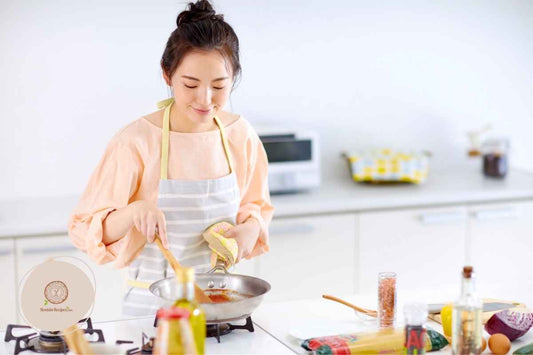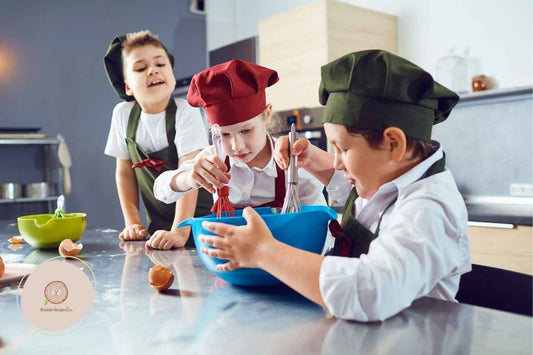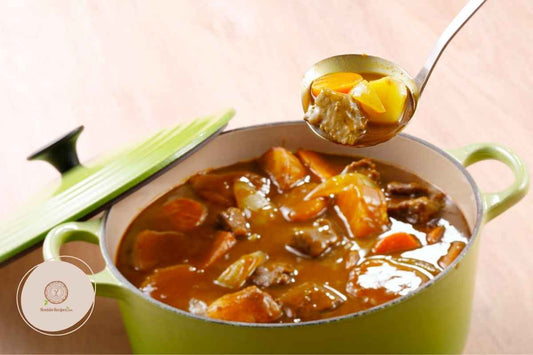Kids in the Kitchen: Recipes, Joy & Family Traditions
Share

Introduction
There’s something magical about kids in the kitchen. Think of giggles as a spoonful of frosting sneaks past little lips, flour-dusted counters that look like snow, and proud smiles when the first bite of a homemade pancake is finally ready. These moments aren’t just charming—they’re the building blocks of memory, heritage, and family connection.
Having kids in the kitchen regularly creates bonds that last a lifetime. It turns meals into lessons, and recipes into living family stories.
Table of contents

Wise Words on Kids in the Kitchen
“Cooking is one of the great gifts you can give to those you love. It says ‘you’re important enough to me to spend the time and effort to cook for you.’”
Ina Garten, celebrity chef
The Skills Kids Learn in the Kitchen
From measuring flour to setting the table, every task teaches something. Here’s what kids in the kitchen take away:
- Math Made Delicious – Fractions come alive when dividing cookie dough or pancake batter.
- Problem-Solving – Out of sugar? Substitution sparks creativity.
- Confidence & Creativity – Decorating a plate or inventing toppings builds pride.
- Responsibility – Messes happen—but clean-up is part of the lesson.
- Communication – Reading recipes aloud and explaining steps improves literacy.
- Patience & Gratification – Waiting for bread to rise teaches that some good things take time.
These skills that kids in the kitchen learn don’t fade—they ripple into school, friendships, and eventually, adulthood.
5 Easy Recipes for Kids in the Kitchen

Easy-Peasy Pancakes
Why it’s great for kids in the kitchen: Pancakes are a breakfast classic that teach measuring, mixing, and flipping—all with delicious results. The ingredients are simple, the steps are repetitive (great for reinforcement), and the customization options are endless.
Skills Learned:
- Measuring dry and wet ingredients
- Cracking eggs cleanly
- Stirring and combining without overmixing
- Cooking on a griddle with supervision
Make It More Fun: Set up a “pancake bar” with fresh fruit, nuts, whipped cream, and chocolate chips. Have kids in the kitchen create names for their stacks—Banana Tower, Blueberry Blizzard, or Choco-Cake Mountain.
Memory Maker Tip: Use a recipe passed down in your family and tell the story of the first time you made it together.
nk
Build-Your-Own Sandwiches
Why it’s great for kids in the kitchen: This is the ultimate beginner recipe for kids in the kitchen—no heat required, maximum creativity encouraged.
Skills Learned:
- Layering ingredients for taste and texture
- Spreading sauces evenly
- Balancing savory and sweet flavors
- Safe cutting skills with kid-friendly knives
Make It More Fun: Turn the kitchen into a “sandwich shop.” Give kids a printed menu and let them take “orders” from family members.
Memory Maker Tip: Share your favorite school lunch memories as they build theirs.

One-Pot Pasta
Why it’s great for kids in the kitchen: This dish is a safe introduction to stovetop cooking, teaching how to combine ingredients, stir safely, and taste for seasoning.
Skills Learned:
- Measuring and pouring liquids without spills
- Stirring safely over low to medium heat
- Following cooking times closely
- Understanding seasoning basics
Make It More Fun: Let kids in the kitchen pick the pasta shape and add their own mix-ins—peas, shredded cheese, diced tomatoes, or mini meatballs.
Memory Maker Tip: Connect it to your heritage—share how pasta night looked in your family growing up.
No-Bake Cookie Clusters
Why it’s great for kids in the kitchen: These treats deliver quick results, perfect for younger children with shorter attention spans.
Skills Learned:
- Mixing ingredients thoroughly
- Shaping portions by hand or with scoops
- Practicing patience while treats chill in the fridge
Make It More Fun: Use cookie cutters or silicone molds to create heart, star, or animal shapes. Ask kids in the kitchen to name each cookie after a family member or pet.
Memory Maker Tip: Tie the recipe to a holiday tradition—“These were Grandma’s go-to Christmas cookies.”
Mini Muffin Pizzas
Why it’s great for kids in the kitchen: A personalized twist on pizza night, these mini versions give everyone a chance to make something just for them.
Skills Learned:
- Assembling and layering ingredients
- Choosing flavor combinations
- Learning oven safety with supervision
- Timing bakes for the perfect crust
Make It More Fun: Offer toppings in small bowls—pepperoni, bell peppers, olives, pineapple—and let kids in the kitchen create their “signature pizza.”
Memory Maker Tip: Share your favorite pizza place story from childhood.

Life Lessons Kids Learn in the Kitchen
“Cooking with children not only fosters healthy eating habits but also teaches valuable life skills … kids learn by reading and following a step-by-step recipe. … There’s a lot of real-world learning involved.”
Jessica Battilana (King Arthur Baking Company)
How Kids in the Kitchen Preserve Traditions
When we invite kids in the kitchen, we don’t just cook—we tell stories. The messy pie that didn’t set, the first lopsided pancake, the sandwich piled with too many pickles—all become the family tales we tell for years. Those “remember when…” moments grow into a living family narrative, passed from one generation to the next around the dinner table.
Every time kids in the kitchen stir a pot beside a grandparent or kneads dough alongside a parent, they’re carrying on rituals that go back decades. Maybe it’s Grandma’s Sunday roast, carefully seasoned with herbs from her own garden. Or maybe it’s Dad’s quirky way of stacking sandwiches, complete with the odd condiment combinations he swears by. Having kids in the kitchen ensures that those details aren’t forgotten—they’re witnessed, remembered, and repeated.
Tradition is more than just following a recipe card; it’s the laughter in the room, the smells that drift through the house, and the gentle corrections when a spoonful of salt becomes a handful. These messy, imperfect, joy-filled experiences are the threads that weave your family’s story. When you let kids in the kitchen, you’re not only teaching them to cook—you’re preserving the essence of where your family has been and ensuring it continues for where you’re going.
Turning Kids’ Kitchen Moments into a Family Cookbook
Want to learn how to make a custom cookbook? Imagine bottling up those messy, joyful kitchen memories into something you can hold. With RootsInRecipes.com, you can:
- Sign Up – It's FREE!
- Upload Recipes & Stories – Add photos, anecdotes, even kids’ doodles.
- Customize Layouts – Organize by child, meal, or tradition.
- Print or Share – Create beautiful coil-bound cookbooks starting at $5.99 + $0.25/page.
Pro Tip: Dedicate a section to each child—“Ella’s Breakfast Creations” or “Liam’s Pizza Legends.”
Kitchen Legacy Starts with Little Hands
Cooking together is about so much more than food. It’s how we pass love, patience, and resilience down the line. Kids in the kitchen are tomorrow’s memory keepers, the ones who will carry your family flavors and stories into the future. Every crooked pancake flip, every too-salty soup, every burst of laughter at the table becomes part of a larger tapestry—a family legacy woven through shared meals.
These moments for kids in the kitchen matter because they remind us that traditions don’t live in recipe cards alone; they live in the act of cooking together. When you bring kids in the kitchen, you’re making sure your story continues long after the dishes are done.
❤️ Don’t let your family traditions disappear.
Frequently Asked Questions
What age is best to start involving kids in the kitchen?
Toddlers can help stir, sprinkle, or wash vegetables. As kids grow, increase responsibility with age-appropriate tasks. By the time they reach grade school, kids in the kitchen can handle measuring ingredients, cracking eggs, or even using kid-safe knives. The key is gradual responsibility, layered with encouragement and patience.
How do I keep kids safe while cooking?
Teach heat awareness, knife safety (start with kid-friendly tools), and supervise closely during stovetop or oven use. Safety lessons should evolve with age: younger children can focus on handwashing and safe stirring, while older kids can learn oven basics and sharp knife handling under guidance. Safety always comes before speed.
What recipes are best for beginners?
No-bake treats, sandwiches, and simple pancake mixes are perfect for starters. As confidence grows, introduce stovetop or oven-based meals with close supervision. Remember, the goal isn’t perfection—it’s enjoyment. Let kids in the kitchen choose their favorite flavors to make the process engaging and encourage ownership of their creations.
How do I capture these memories for the future?
Take photos, jot down funny kitchen quotes, and upload them into a custom cookbook. Consider adding voice recordings, drawings of their favorite foods, or even small “chef notes” written by the kids themselves. By weaving recipes with these little touches, you’re ensuring those precious kids in the kitchen memories live forever.



